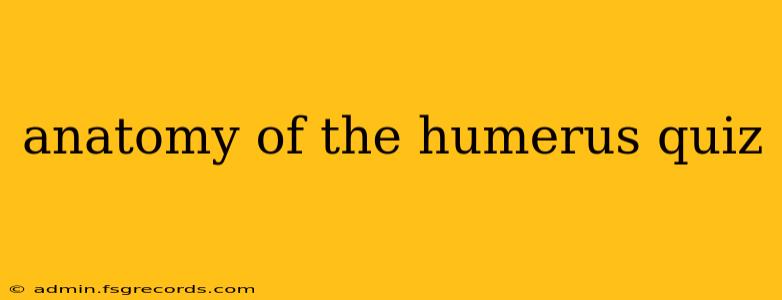The humerus, the long bone of your upper arm, plays a crucial role in arm movement and overall upper body function. Understanding its intricate anatomy is essential for anyone studying anatomy, physical therapy, orthopedics, or related fields. This quiz will test your knowledge of the humerus's key features, from its proximal to distal ends. Let's see how well you know this vital bone!
Instructions: Choose the best answer for each multiple-choice question. At the end, you'll find the answer key to check your results.
The Quiz:
1. Which of the following is NOT a feature of the proximal humerus?
a) Greater tubercle b) Lesser tubercle c) Capitulum d) Head
2. The anatomical neck of the humerus is located:
a) Distal to the surgical neck b) Proximal to the surgical neck c) At the midpoint of the humerus d) On the medial side of the humerus
3. The intertubercular groove (sulcus) of the humerus houses:
a) The radial nerve b) The ulnar nerve c) The biceps brachii tendon d) The brachial artery
4. The deltoid tuberosity is a roughened area on the humerus providing attachment for:
a) The pectoralis major muscle b) The latissimus dorsi muscle c) The deltoid muscle d) The triceps brachii muscle
5. The radial fossa on the distal humerus articulates with:
a) The ulna b) The radius c) The scapula d) The clavicle
6. The coronoid fossa on the distal humerus receives the:
a) Olecranon process of the ulna during forearm extension b) Coronoid process of the ulna during forearm flexion c) Head of the radius during forearm supination d) Head of the radius during forearm pronation
7. The capitulum of the humerus articulates with:
a) The ulna b) The radius c) Both the radius and ulna d) The scapula
8. The trochlea of the humerus articulates with:
a) The head of the radius b) The olecranon process of the ulna c) The coronoid process of the ulna d) Both the coronoid process and the trochlear notch of the ulna
9. The surgical neck of the humerus is a common site for:
a) Fractures b) Dislocations c) Infections d) All of the above
10. The medial epicondyle of the humerus serves as an attachment site for:
a) Pronator teres muscle b) Flexor carpi ulnaris muscle c) Flexor carpi radialis muscle d) All of the above
Answer Key:
- c) Capitulum (This is located on the distal humerus)
- b) Proximal to the surgical neck
- c) The biceps brachii tendon
- c) The deltoid muscle
- b) The radius
- b) Coronoid process of the ulna during forearm flexion
- b) The radius
- d) Both the coronoid process and the trochlear notch of the ulna
- d) All of the above
- d) All of the above
How did you do? Let us know your score in the comments below! This quiz is just a starting point for your learning. Further research and anatomical study will solidify your understanding of the humerus and its complex role in the human body.

